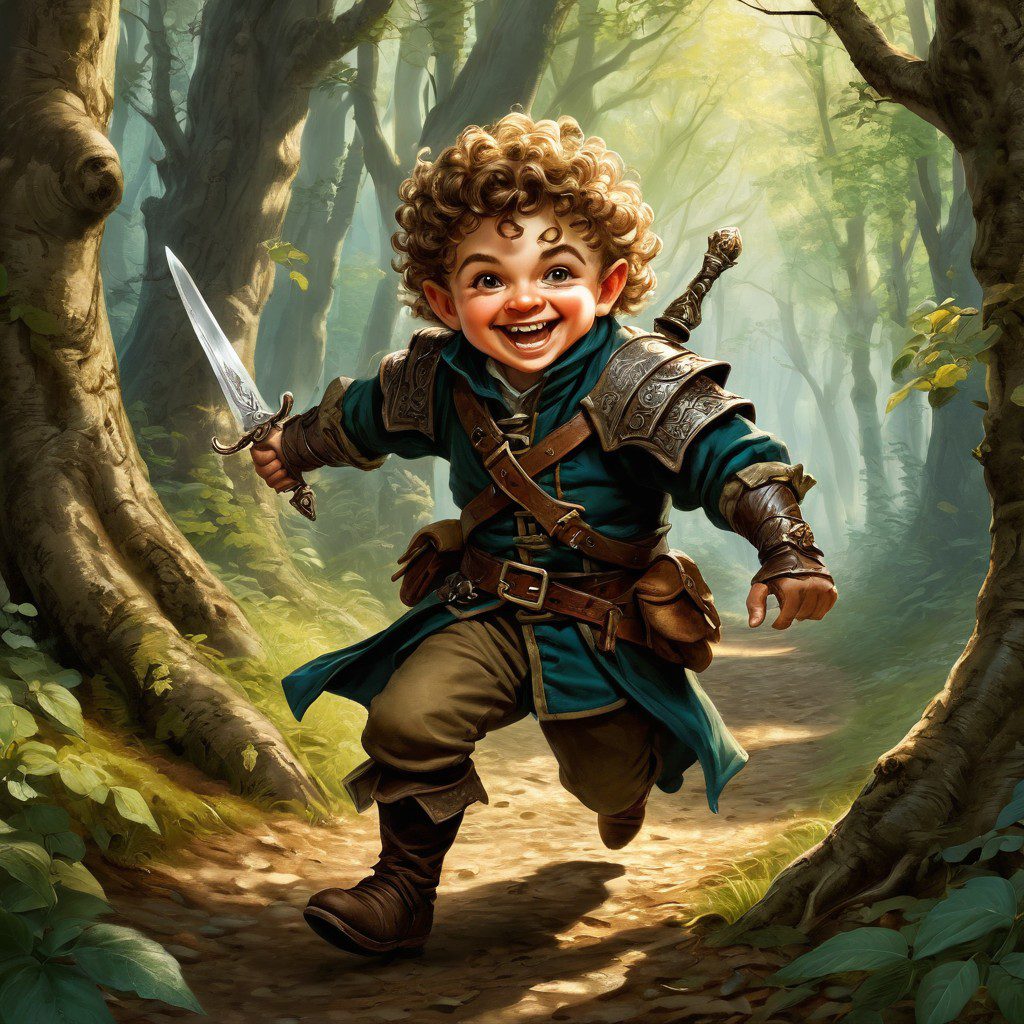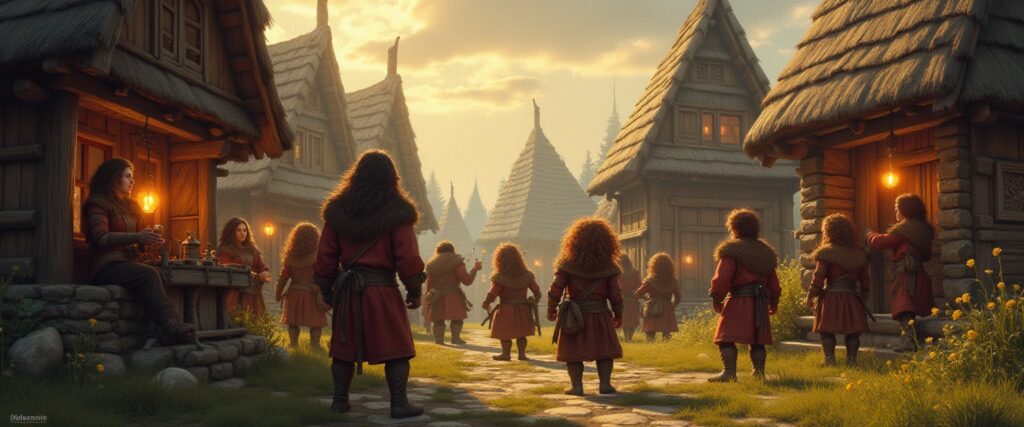Halflings: The Small but Courageous Folk of Fantasy

Halflings, sometimes called “hobbits” in certain universes, are a small and nimble race often associated with kindness, curiosity, and a love for the simple pleasures of life. Though physically unassuming, Halflings are renowned for their bravery, resourcefulness, and ability to survive in challenging situations. They have become an iconic race in fantasy literature, especially thanks to J.R.R. Tolkien’s The Lord of the Rings, where hobbits like Frodo and Sam prove that even the smallest person can change the course of histor
Halflings appear in many forms of modern fantasy, particularly in Dungeons & Dragons, where they are portrayed as a race of adventurers who thrive on exploration, friendship, and cleverness. Despite their small stature, they embody the idea that courage and heart matter more than size or strength.
Origins of Halflings in Fantasy
Halflings, as a fantasy race, were popularized by J.R.R. Tolkien’s The Hobbit (1937) and The Lord of the Rings trilogy (1954–1955), where they were called hobbits. Tolkien’s hobbits are small, peaceful people who prefer a quiet, rural life but often find themselves swept up in grand adventures. While Tolkien did not invent the concept of small folk, his portrayal of hobbits deeply influenced the depiction of Halflings in later fantasy works.
In Dungeons & Dragons, Halflings are a core playable race, introduced in the game’s earliest editions. They share many traits with Tolkien’s hobbits, but D&D has developed its own unique Halfling culture and characteristics, emphasizing their wanderlust, cunning, and resilience.
Physical Appearance

Halflings are small humanoid creatures, typically standing around 3 to 4 feet tall. They have a slight build, with rounded features and an often childlike appearance, though they are fully adult in terms of maturity.
- Size and Proportions: Halflings are usually slim and nimble, with excellent dexterity. Their small stature gives them certain advantages, particularly in avoiding danger or sneaking into places unnoticed.
- Hairy Feet: One of the most iconic features of Tolkien’s hobbits, and often adopted in other depictions of Halflings, is their large, hairy feet. In some depictions, Halflings go barefoot, their feet naturally tough and well-suited for long journeys.
- Appearance Variation: Depending on the setting, Halflings can vary slightly in appearance, sometimes leaning toward more human-like traits or possessing a more rustic, fairy-tale look.
Halflings in Dungeons & Dragons
In Dungeons & Dragons, Halflings are portrayed as a race of cheerful, clever, and brave adventurers. They are known for their light-footedness, sharp wits, and knack for getting out of dangerous situations. Despite their small size, Halflings are often underestimated, as they are capable of great courage and remarkable deeds.
Subraces of Halflings
In Dungeons & Dragons, there are several different types of Halflings, each with their own traits and abilities:
- Lightfoot Halflings: The most common type of Halfling, Lightfoots are known for their stealth and adaptability. They are naturally inclined toward sneaky or roguish professions and have a talent for blending into crowds or hiding from danger. Lightfoot Halflings can move through the world almost unnoticed, and they often take advantage of their size and agility.
- Stout Halflings: Stouts are hardier and more resilient than their Lightfoot cousins, with a greater ability to withstand poisons and other physical hardships. They have a reputation for toughness and a slightly more grounded, cautious approach to life. This makes them excellent adventurers, especially when facing dangerous terrain or enemies.
- Ghostwise Halflings: A less common subrace, Ghostwise Halflings are known for their telepathic abilities and reclusive nature. They live in isolated communities and have a deep connection to the spiritual world, often communicating without words.
Halfling Traits in D&D
Halflings in Dungeons & Dragons possess several unique traits that reflect their agility, bravery, and unassuming nature:
- Lucky: One of the most iconic Halfling traits is their luck. Halflings have the uncanny ability to avoid disaster, often described in D&D as a racial feature called Lucky, which allows them to reroll a die when they roll a 1 on an attack, ability check, or saving throw. This reflects the idea that Halflings are “blessed by fortune” and often manage to escape danger through pure serendipity.
- Brave: Halflings are renowned for their bravery, especially when facing overwhelming odds. In D&D, Halflings have advantage on saving throws against fear, reflecting their inner courage and the fact that they refuse to be intimidated by larger or more powerful foes.
- Nimble and Dexterous: Halflings are naturally light-footed, making them excellent at sneaking, dodging, and performing acrobatic feats. Their small size makes them difficult to target, and their natural dexterity gives them an edge in both combat and stealthy situations.
- Halfling Nimbleness: This trait allows Halflings to move through spaces occupied by creatures larger than themselves, making them perfect for tight spaces or crowded areas where others might struggle.
Culture and Society
Halflings in D&D are often portrayed as a peaceful and tight-knit race. They prefer the comfort of home, good food, and close friendships over grand ambitions or power. Halfling society is typically rural, with a focus on farming, community, and a carefree lifestyle. However, despite their preference for peace and quiet, Halflings are drawn to adventure, curiosity, and exploration.
- Wanderlust: While some Halflings are content to stay in their small villages, many are driven by wanderlust, the desire to explore the world and experience all it has to offer. This trait makes them natural adventurers, though they often return to their homes with stories of faraway places.
- Community-Oriented: Halflings are highly social creatures, valuing family, friendship, and loyalty above all. Their communities are close-knit, and they often look out for one another in times of need. Even when far from home, Halflings are known for their ability to make friends quickly and form bonds with people of all races.
- Optimistic and Resourceful: Halflings are typically optimistic, always looking for the bright side of things, even in the direst situations. They have a knack for making the best of difficult circumstances, whether by using their cleverness, charm, or sheer luck to get out of trouble.
Halflings in Modern Media
Halflings, as a fantasy archetype, have spread beyond Dungeons & Dragons into many forms of modern media. Their friendly, unassuming nature, combined with their inherent courage, makes them compelling characters in stories of adventure and discovery.
1. Tolkien’s Hobbits
J.R.R. Tolkien’s depiction of hobbits in The Hobbit and The Lord of the Rings is perhaps the most famous and influential portrayal of small, brave folk in fantasy. Characters like Bilbo and Frodo Baggins embody the heart of the Halfling archetype—unwilling adventurers who rise to greatness through courage, loyalty, and determination.
Hobbits in Tolkien’s world live in the peaceful Shire, a rural paradise where they enjoy a simple life of farming, eating, and celebrating. However, when faced with great danger, they show extraordinary bravery and resilience, proving that even the smallest person can change the course of history.
2. Video Games
Halflings often appear in fantasy video games, particularly in RPGs and games inspired by Dungeons & Dragons. In games like Baldur’s Gate, Neverwinter Nights, and Divinity: Original Sin, Halflings can be chosen as player characters or encountered as NPCs, typically known for their dexterity, stealth, and charisma.
In many games, Halflings are depicted as rogues, thieves, or adventurers who rely on their agility and cunning rather than brute strength.
3. Fantasy Literature
Halfling-like characters are a staple of modern fantasy literature, often appearing as charming sidekicks or unexpected heroes. Their small size and big hearts make them relatable and likable characters, embodying the idea that heroism is not defined by physical strength or power, but by determination and bravery.
Strengths and Weaknesses of Halflings
Strengths:
- Courage and Resilience: Despite their small size, Halflings are incredibly brave and resilient. They are able to stand up to overwhelming odds and face danger head-on, often when others would flee.
- Stealth and Agility: Halflings’ small size and natural dexterity make them excellent at stealth, sneaking, and avoiding danger. They can navigate difficult terrain, dodge attacks, and outmaneuver their enemies.
- Luck and Fortune: Halflings are famously lucky, with an innate ability to avoid disaster or turn bad situations to their advantage. This makes them unpredictable in combat and adventure, as fortune often seems to favor them.
- Optimism and Friendliness: Halflings are naturally optimistic and social, forming friendships easily and often acting as the glue that holds adventuring parties together. Their friendly demeanor and positive outlook can lift the spirits of those around them.
Weaknesses:
- **
Small Stature**: Halflings’ small size makes them less physically imposing than other races. They lack the brute strength or endurance of larger races, and they may struggle in direct confrontations with bigger, stronger foes.
- Underestimated: Due to their unassuming appearance, Halflings are often underestimated by others. While this can sometimes work in their favor, it can also make it harder for them to be taken seriously in situations that require authority or intimidation.
- Reluctant Adventurers: Many Halflings prefer a peaceful, quiet life, and may be reluctant to take on dangerous or risky tasks. Their love for home and comfort can sometimes conflict with the adventurous nature of a quest-driven world.
The Legacy of Halflings: Courage in Small Packages
Halflings have become a beloved race in fantasy due to their charm, bravery, and resourcefulness. Though small in stature, they are often the heart of any adventuring party, bringing humor, optimism, and courage to even the darkest of journeys. Their resilience in the face of adversity, combined with their knack for avoiding danger, makes them one of the most relatable and enduring races in the fantasy genre.
Whether as the humble hobbits of Tolkien’s Middle-earth or the daring adventurers of Dungeons & Dragons, Halflings continue to inspire readers, gamers, and audiences with the idea that true heroism comes from within—and that even the smallest person can make the biggest difference.
